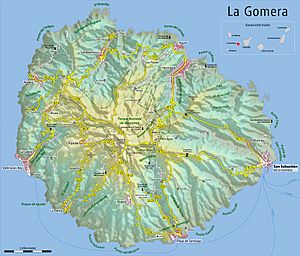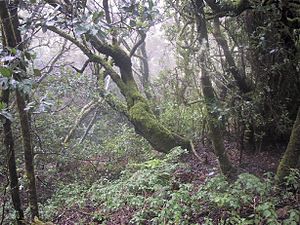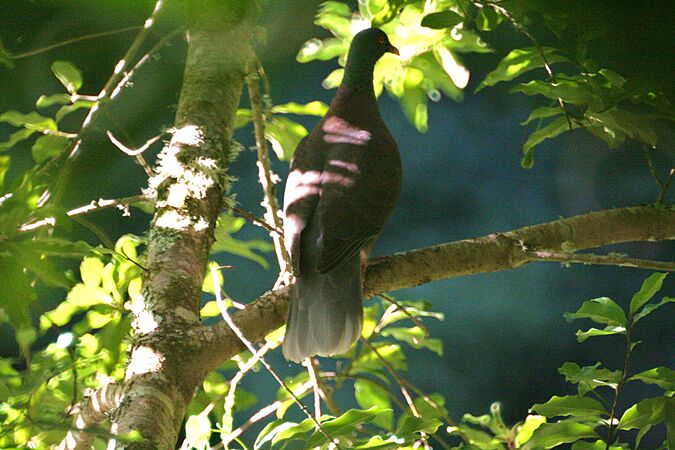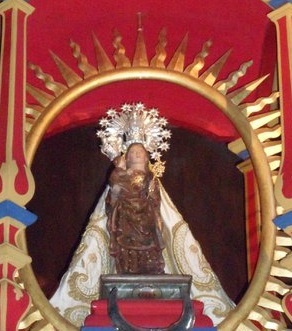La Gomera facts for kids
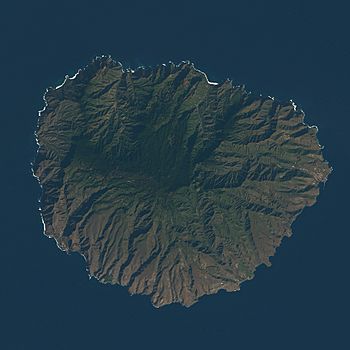
Satellite view of La Gomera
|
|
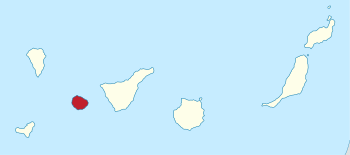 |
|
| Geography | |
|---|---|
| Location | Atlantic Ocean |
| Coordinates | 28°06′54″N 17°13′30″W / 28.11500°N 17.22500°W |
| Archipelago | Canary Islands |
| Area | 370.03 km2 (142.87 sq mi) |
| Coastline | 100 km (60 mi) |
| Highest elevation | 1,487 m (4,879 ft) |
| Highest point | Garajonay |
| Administration | |
|
Spain
|
|
| Autonomous Community | Canary Islands |
| Province | Santa Cruz de Tenerife |
| Capital and largest city | San Sebastián de la Gomera (pop. 9,093, in 2019) |
| Demographics | |
| Demonym | gomero/-a |
| Population | 22,426 |
| Pop. density | 58.1 /km2 (150.5 /sq mi) |
| Languages | Spanish (specifically Canarian Spanish and Silbo Gomero) |
| Ethnic groups | Spanish, Canary Islanders, other minority groups |
| Additional information | |
| Time zone |
|
| • Summer (DST) | |
La Gomera is a beautiful island that's part of Spain's Canary Islands. It's located in the Atlantic Ocean, not far from the coast of Africa. Even though it's the third-smallest of the eight main Canary Islands, it's packed with amazing nature and history.
The island covers about 370 square kilometers (143 square miles). Around 22,426 people live here, making it one of the less crowded islands. The main town and capital is San Sebastián de La Gomera. This is where the island's government, called the cabildo insular, is located.
Contents
Governing La Gomera
La Gomera is part of the province of Santa Cruz de Tenerife in Spain. The island is divided into six smaller areas called municipalities. Each municipality has its own local government. The main island government, known as the cabildo insular, is based in the capital, San Sebastián. This council helps manage things like roads, water, and local services for everyone on the island.
Island Geography: Mountains and Ravines
La Gomera was formed by volcanoes and has a round shape, about 22 kilometers (14 miles) across. It's very mountainous, with steep slopes and deep valleys. The highest point is Alto de Garajonay, which stands 1,487 meters (4,879 feet) tall.
Imagine an orange cut in half and then sliced into segments. That's a bit like La Gomera! The deep cuts are called barrancos, which are steep ravines. These ravines were created by erosion over millions of years.
Amazing Ecosystems
The island's unique geography creates many different environments.
The Cloud Forest of Garajonay
High up in the barrancos, you'll find a special type of forest called laurisilva, or laurel rain forest. This forest gets a lot of rain, sometimes up to 50 inches each year! The upper parts of this forest are almost always covered in clouds and mist. This makes the plants grow very lush and diverse.
This amazing area is protected as Garajonay National Park. In 1986, UNESCO declared it a World Heritage Site. This means it's a very important natural place that needs to be preserved. Many trails crisscross the park, offering incredible views.
Climate Zones and Farming
The central mountains of La Gomera act like a sponge, trapping moisture from the trade wind clouds. This creates a cool, misty cloud forest climate in the highlands. Down by the sea, the cliffs are much warmer and sunnier.
Between these two extremes, there are many different small climates. For hundreds of years, people on La Gomera have used clever ways to farm the lower areas. They channel runoff water from the mountains to water their vineyards, fruit orchards, and banana groves.
Island Symbols: Plants and Animals
Every place has its own special symbols! The official natural symbols of La Gomera are the Columba junoniae (a type of laurel pigeon) and the Persea indica (a tree called viñátigo).
Unique Culture of La Gomera
La Gomera has a rich and interesting culture, especially known for its food and a very special way of communicating.
Local Food and Flavors
The island's local wine is quite unique. It's often served with a tapa (a small snack) of local cheese, roasted pork, or goat meat. Other tasty foods include almogrote, which is a spread made from cheese. There's also miel de palma, a sweet syrup made from palm trees, and "escaldón," a porridge made from gofio flour.
The Whistled Language: Silbo Gomero
One of the most amazing things about La Gomera is its ancient way of communicating called Silbo Gomero. This is a whistled speech that people use to talk across the island's deep ravines. It's so loud that it can be heard up to two miles away!
This unique whistled language was created by the island's first inhabitants, the Guanches. When Spanish settlers arrived in the 16th century, they also learned and used Silbo Gomero. For a while, it was in danger of disappearing. So, at the start of the 21st century, the local government made it a required subject for all children to learn in school. Learning Silbo Gomero might even help scientists understand how languages are formed!
Ancient Beliefs and History
Long ago, the original people of La Gomera, the Guanches, worshipped their god named Orahan. The highest point of the island was a sacred place for them. In 1489, when the Spanish arrived, many Guanches went to this sacred area to make their last stand. This is where the Spanish conquest of La Gomera ended.
Archaeologists have found special stone structures there. These might have been altars where the Guanches made offerings of goats and sheep to Orahan. They also buried their dead in caves. Today, most people on the island follow Christianity, but some old traditions and the unique spirit of the Guanches still play a role in their culture.
Christopher Columbus's Visits
Did you know that Christopher Columbus stopped at La Gomera before his famous journey across the Atlantic in 1492? He needed to get food and water for his crew. He planned to stay only four days, but the Countess of La Gomera, Beatriz de Bobadilla y Ossorio, helped him so much that he ended up staying for a whole month! When he finally left on September 6, 1492, she even gave him sugarcane cuttings, which were the first to reach the New World.
Columbus visited La Gomera two more times on his later voyages to the Americas. The house in San Sebastián where he is believed to have stayed is now a popular place for tourists to visit.
Fun Festivals
One of the most important festivals on La Gomera is for the Virgin of Guadalupe, who is the patron saint of the island. This festival takes place on the Monday after the first Saturday in October.
Every five years, there's an even bigger celebration called the Bajada de la Virgen de Guadalupe. This is when the statue of the Virgin is brought from her chapel in Puntallana to the capital. She travels by boat to the beach of San Sebastián de La Gomera. Then, she is carried around the entire island for two months! The last time this special event happened was in 2018.
Notable People from La Gomera
- Antonio José Ruiz de Padrón (1757–1823), a priest and politician.
- José Aguiar (1895–1975), a famous painter.
- Pedro García Cabrera (1905–1981), a well-known writer and poet.
- Tim Hart (1948–2009), an English folk musician who lived on the island.
- Manuel Mora Morales (born 1952), a writer, filmmaker, and editor.
- Oliver Weber (born 1970), a German photographer and professor.
See also
 In Spanish: La Gomera para niños
In Spanish: La Gomera para niños


